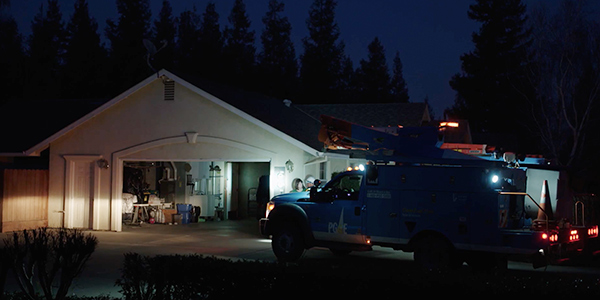Pacific Gas and Electric on Thursday acknowledged it needs to get better at notifying local authorities and customers before shutting off power to prevent wildfires, but the utility said it performed far better this fall than it did last year.
In its report to the California Public Utilities Commission on the public safety power shutoffs (PSPS) of Oct. 25-28, the largest this year, PG&E said it had generally met its goals of notifying emergency officials and residents about potential blackouts in the days ahead of an event, but it still sees “opportunities for improvement”
That was unlike the PSPS events last October, when PG&E blacked out more than 2 million residents, many without warning. The utility’s websites crashed under heavy traffic, requiring state agencies to intervene. Its phone lines were also overloaded, and its shutoff maps often were inconsistent or incorrect, then-CEO Bill Johnson said. (See PG&E Restores Power amid Backlash.)
In a meeting Nov. 5, Lee Palmer, director of the CPUC’s Safety and Enforcement Division, said the state’s three big investor-owned utilities, including PG&E, had generally provided PSPS notifications at the “right cadence” in late October, alerting local authorities 48 to 72 hours before an event and telling customers they could lose power 24 to 48 hours beforehand.
In some cases, PG&E failed to notify customers of imminent blackouts because its “process broke down,” Palmer said. Southern California Edison and San Diego Gas & Electric had to make emergency adjustments to their shutoffs because of shifting Santa Ana winds and did not alert some residents before cutting power, he said.
In its report, PG&E said it had made significant strides since last year but acknowledged shortcomings, including that its “delivery of in-event information to [local emergency authorities and customers] needs to improve.”
“Although the situation has improved relative to 2019, there are still some timing inconsistencies between information posted in our online portal, information posted on our customer website and that provided by PG&E liaisons and representatives,” the utility said. “PG&E is working for ways to improve and expedite our information processes and flows to better serve our local partners and first responders.”
CPUC President Marybel Batjer, a vocal critic of PG&E after the 2019 shutoffs, acknowledged that the IOUs had “greatly improved, particularly the PG&E service area, over last year.” She said, however, that the commission was still waiting to hear from county officials and community representatives about their experiences in the blackouts.
In the late-October PSPS events, PG&E shut down power to 345,000 account customers, or about 1 million residents, across 35 counties. SCE blacked out 19,000 customers, and SDG&E shut off power to about 2,900 customers.
“The scale of these PSPS events makes it clear to all of us that the threat of wildfires and impact of PSPS events are not limited to a specific county or city,” Palmer said. “This is a statewide and regional concern.”
Batteries not Provided
CPUC commissioners focused in their Nov. 5 meeting on another problem: the lack of backup batteries provided by IOUs to at-risk residents.
PG&E had promised to deliver 8,000 backup batteries to customers who rely on medical devices in 2020 but had only provided 2,500 units, Palmer said. The utility has said it will deliver 1,500 more batteries by the end of the year, he said.
Rather than address the shortfall in its report, PG&E said it had worked “to provide a cumulative total of approximately 2,525 portable batteries to qualifying customers who need power during a PSPS event” along with food boxes, hotel stays and wellness checks to seniors and others in need.
SCE told the CPUC it would enroll 2,500 residents in its battery-backup program in 2020 but so far has provided only 200 batteries, Palmer said.
Logistical holdups and manufacturing delays caused by the COVID-19 pandemic are partly to blame, he said.
Batjer said she had repeatedly asked the utilities for updates on battery distributions during briefings this year, but the IOUs had only recently provided numbers. The figures fell short of what the commission had hoped for, commissioners said.
“None of them, frankly, lived up to the pledge they made to us in August and then updated by written memo in September,” Batjer said. “It’s something we must indeed continue to work on, so the medically baseline and critically in-need customers have backup batteries that they need during these unfortunately called PSPS.”




